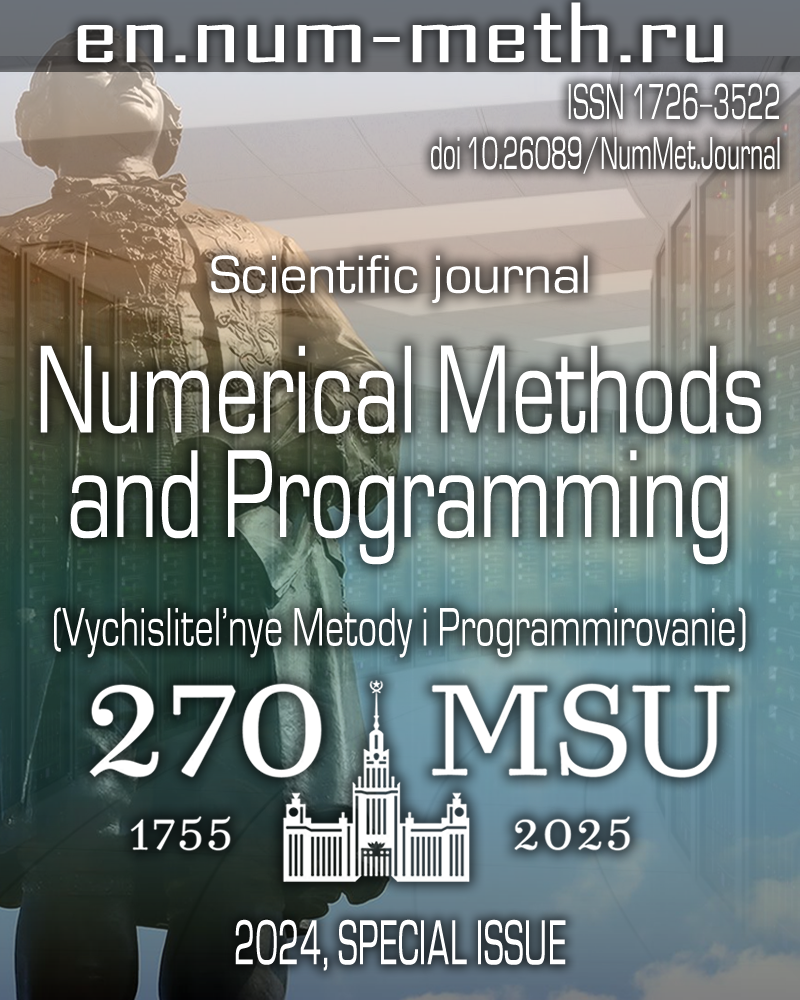DOI: https://doi.org/10.26089/NumMet.2024s04
Experience of applying convolutional neural networks to inverse problems of seismic exploration
Keywords:
Abstract
The paper is devoted to the study of the possibility of using modern convolutional neural networks to solve problems of reconstructing the position of geological inclusions and estimating the scalar parameters of the models used based on seismic exploration data. Synthetic seismograms calculated by explicit-implicit grid-characteristic schemes are used to form training and validation samples. The paper considers two network architectures for joint machine learning problems and compares the results of the calculated estimates with single forecast models. A significant increase in forecast quality is demonstrated.
Published
Issue
Section
References
- M. E. Badley, Practical Seismic Interpretation (IHRDC Publishers, Boston, 1985).
- B. Russel and D. Hampson, “Comparison of Poststack Seismic Inversion Methods,” SEG Tech. Program Expand. Abstr. 1991, 876-878 (1991).
doi 10.1190/1.1888870 - D. Kosloff, J. Sherwood, Z. Koren, et al., “Velocity and Interface Depth Determination by Tomography of Depth Migrated Gathers,” Geophysics 61 (8), 1511-1523 (1996).
doi 10.1190/1.1444076 - G. Roethe and A. Tarantola, “Use of Neural Networks for Inversion of Seismic Data,” SEG Tech. Program Expan. Abstr. 1991, 302-305 (1991).
doi 10.1190/1.1888938 - G. Röth and A. Tarantola, “Neural Networks and Inversion of Seismic Data,” J. Geophys. Res. Solid Earth 99 (B4), 6753-6768 (1994).
doi 10.1029/93JB01563 - E. P. Leite, A. C. Vidal, J. F. Bueno, and R. D. C. Duarte, “3D Acoustic Impedance and Porosity Mapping from Seismic Inversion and Neural Networks,” SEG Tech. Program Expand. Abstr. 2010, 2226-2230 (2010).
doi 10.1190/1.3513291 - D. Cao, P. An, and S. Liu, “Elastic-Parameters Inversion from EI Based on the Deep-Learning Method,” SEG Tech. Program Expand. Abstr. 2018, 640-644 (2018).
doi 10.1190/segam2018-2998479.1 - S. Eladj, M. Z. Doghmane, L. Aliouane, and S.-A. Ouadfeul, “Porosity Model Construction Based on ANN and Seismic Inversion: A Case Study of Saharan Field (Algeria),” in Advances in Geophysics, Tectonics and Petroleum Geosciences (Springer, Cham, 2022), pp. 241-243.
doi 10.1007/978-3-030-73026-0_55 - W. Lewis and D. Vigh, “Deep Learning Prior Models from Seismic Images for Full-Waveform Inversion,” SEG Tech. Program Expand. Abstr. 2017, 1512-1517 (2017).
doi 10.1190/segam2017-17627643.1 - B. Wu, D. Meng, L. Wang, et al., “Seismic Impedance Inversion Using Fully Convolutional Residual Network and Transfer Learning,” IEEE Geosci. Remote Sens. Lett. 17 (12), 2140-2144 (2020).
doi 10.1109/LGRS.2019.2963106 - V. C. Dodda, L. Kuruguntla, S. Razak, et al., “Seismic Lithology Interpretation Using Attention Based Convolutional Neural Networks,” 2023 3rd Int. Conf. on Intelligent Communication and Computational Techniques (2023), 1-5.
doi 10.1109/ICCT56969.2023.10075964 - Q. Sun, X. Wang, H. Ni, et al., “Fault Identification of U-Net Based on Enhanced Feature Fusion and Attention Mechanism,” Electronics 12 (12), Article Number 2562 (2023).
doi 10.3390/electronics12122562 - Y.-Q. Wang, Q. Wang, W.-K. Lu, et al., “Seismic Impedance Inversion Based on Cycle-Consistent Generative Adversarial Network,” Pet. Sci. 19 (1), 147-161 (2022).
doi 10.1016/j.petsci.2021.09.038 - V. Golubev and M. Anisimov, “Application of Convolutional Networks for Localization and Prediction of Scalar Parameters of Fractured Geological Inclusion,” Int. J. Appl. Mech. 16 (5), Article Number 2450064 (2024).
doi 10.1142/S1758825124500649 - Y. Zhang and Q. Yang, “An Overview of Multi-Task Learning,” Natl. Sci. Rev. 5 (1), 30-43 (2018).
doi 10.1093/nsr/nwx105 - M. Crawshaw, “Multi-Task Learning with Deep Neural Networks: A Survey,” arXiv: 2009.09796v1 [cs.LG] (2020).
doi 10.48550/arXiv.2009.09796 - G. S. Martin, R. Wiley, and K. J. Marfurt, “Marmousi2: An Elastic Upgrade for Marmousi,” Lead. Edge 25 (2), 156-166 (2006).
doi 10.1190/1.2172306 - I. S. Nikitin, N. G. Burago, V. I. Golubev, and A. D. Nikitin, “Continual Models of Layered and Block Media with Slippage and Delamination,” Procedia Struct. Integr. 23, 125-130 (2019).
doi 10.1016/j.prostr.2020.01.074 - I. S. Nikitin and V. I. Golubev, “Explicit-Implicit Schemes for Calculating the Dynamics of Layered Media with Nonlinear Conditions at Contact Boundaries,” J. Sib. Fed. Univ. Math. Phys. 14 (6), 768-778 (2021).
doi 10.17516/1997-1397-2021-14-6-768-778 - I. B. Petrov, V. I. Golubev, and E. K. Guseva, “Hybrid Grid-Characteristic Schemes for Arctic Seismic Problems,” Dokl. Akad. Nauk 501 (1), 67-73 (2021) [Dokl. Math. 104 (3), 374-379 (2021)].
doi 10.1134/S1064562421060132 - O. Ronneberger, P. Fischer, and T. Brox, “U-Net: Convolutional Networks for Biomedical Image Segmentation,” in Lecture Notes in Computer Science (Springer, Cham, 2015), Vol. 9351, pp. 234-241.
doi 10.1007/978-3-319-24574-4_28 - I. Misra, A. Shrivastava, A. Gupta, and M. Hebert, “Cross-Stitch Networks for Multi-Task Learning,” in Proc. IEEE Conf. on Computer Vision and Pattern Recognition , Las Vegas, USA, 2016, pp. 3994-4003.
doi 10.1109/CVPR.2016.433
License
Copyright (c) 2024 В. И. Голубев, М. И. Анисимов

This work is licensed under a Creative Commons Attribution 4.0 International License.


